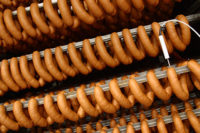When making ready-to-eat (RTE) meat products, the processing step that poses the greatest biological hazard is the post-lethality handling step. It is when meat products are handled after cooking and packaging that they are at the greatest risk for environmental contamination from L. monocytogenes. And how do you control this hazard? I can’t think of a critical control point (CCP) that would effectively control it.
A Listeria program would work better for controlling the Listeria hazard at this step than a CCP. The purpose of a Listeria Control Program (LCP) is to verify the effectiveness of your sanitation program by microbial sampling and testing the environment to identify sources of Listeria contamination that may exist after cleaning and sanitizing.
Historically, cleaning and sanitation wasn’t a priority for most meat processors, because it was typically done by second- or third-shift employees, who had the least training and work experience. Today, top management of RTE meat-processing companies must appreciate the importance of effective cleaning and sanitation of equipment and facilities to prevent niche growth of Listeria. Developing a sanitary culture in RTE facilities is vital. Proper employee training, equipment and supplies are mandatory for proper cleaning and sanitizing. Using written good manufacturing practices (GMPs) for the training is helpful and verifying these GMPs are being implemented as intended is very important. Is the sanitizer concentration correct? Is the water temperature for the sanitizer correct?
In addition, proper design of equipment and facilities are important to facilitate the work of the cleaning and sanitizing crews. Existing equipment may present some challenges as it may not have been designed with proper sanitation in mind. When buying new equipment, particularly equipment that will be used in an RTE packaging room, it is important to avoid new equipment that is not properly designed for cleaning and sanitizing. And existing equipment can be retrofitted to improve cleanability.
The North American Meat Institute, in collaboration with a number of its members, developed a list of design principles for equipment and facilities. For equipment, the 10 principles include: equipment must be cleanable; must be made of compatible materials; must be easy to disassemble so all parts are accessible; there should be no collection of product or liquids; hollow areas should be hermetically sealed or eliminated; surfaces and covers should be free of pits and cracks, which can serve as growth niches for bacteria; equipment should not contribute to unsanitary conditions when running; maintenance enclosures need to be hygienic; should have hygienic compatibility with other plant systems, such as steam, air, water, etc.; and should have a validated, written cleaning procedure.
For facilities, the principles for sanitary design include: establish strict hygienic zones of control; establish control of the flow of people and materials between zones of control; prevent free-standing water in clean rooms; maintain cold temperatures while preventing condensation; control incoming air flow and quality; design the exterior of your facility to reduce contaminates entering the facility; employ an impervious design of building skin; allow adequate space around equipment to facilitate cleaning and sanitizing; use building components (curbs, hidden pipes/conduit, etc) that facilitate cleaning and sanitizing; and integrate sanitation into room design.
A CCP is not nearly as effective in preventing environmental contamination of Listeria as good sanitation, and that requires good people, good practices and good design of equipment and facilities. A good Listeria control program can verify that this sanitation system is effective. NP





Report Abusive Comment